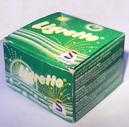Ligretto
|
Box of Ligretto 'Green Pack' playing cards | |
| Players | 2-12 |
|---|---|
| Age range | 5 and up |
| Setup time | < 1 minute |
| Playing time | Approximately 5-10 minutes per round |
| Random chance | Medium |
| Skill(s) required | Hand-eye coordination, speed, counting |
Ligretto is a card game for two to twelve players. The aim of the game is to get rid of all your cards faster than all the other players by discarding them in the middle of the table. Instead of taking turns, all players play simultaneously. Play is fast and lively, and demands attention to the cards being played by others as well as one's own cards. It can be played and enjoyed equally by children from 8 years old to adult with youth being at no disadvantage.
The game, in its present form, was published in 1988 by Germany's Rosengarten Spiele (Rose Garden games) designed by Michael Michaels. An earlier form of the game was published at the start of the 1960s. Since the year 2000 the game has been published by Schmidt-Spiele of Berlin, Germany. In 2009, Playroom Entertainment began publishing the game for North America and other English-speaking countries.
The game is similar to Dutch Blitz, which is based upon the original 1960s Ligretto.[1]
Description
The game uses a special deck of cards: each face is red, green, yellow, or blue, and is numbered from 1 to 10. Each player gets 40 cards (ten of each color) which have a distinctive design on the reverse unique to that player.
Before starting a game, the players shuffle their cards, and put ten cards into a "stack" face down on the table. Three cards are laid out face up next to this stack; these are called the "row". The remaining cards are kept in the player's hand.
When the game starts, players simultaneously discard cards in the middle of the table, building colored piles in ascending numerical order according to color, and only starting new piles with a '1' card (placed anywhere near the middle of the table). New piles can be started anytime a '1' card becomes available to a player. Play is fast, and slow players will miss opportunities to place cards as faster players add to piles before others can react. Near-ties commonly occur among players discarding the same number card on a pile, but the person who was first is clearly the one whose card is underneath.
If players are unable to discard a card from the three "row" cards or from their "stack", they can look at every third card from the cards in their hand and play a card from the top of that pile if it goes on a pile on the table.
Once a player's hand has been completely passed through in this manner, it can be reshuffled by the player who then continues to play.
When one of the three "row" cards is placed in the middle, the space gets filled up with the top card from the "stack".
Play continues at a fast pace, with experienced players usually watching other players' rows and stacks as well as their own.
Once a player has discarded all cards from their "stack" pile, s/he calls out "Ligretto stop!" and ends the round.
Scoring
At the end of each round, all the cards on the table are turned over, returned to players and counted, using the distinctive marking on the reverse side unique to each player.
The players get double penalty-points for each of the cards remaining on their "stacks" and single bonus points for each card discarded in the middle during play. The player who ended the round does not necessarily achieve the highest score. It is also possible to score a negative value in a round.
After the score has been calculated, each player shuffles his 40 cards, and a new round can begin.
Play continues until a player scores 100 points and wins the game.
Game packs
Ligretto comes in red, green, and blue packs. Each pack, containing cards for four players, has a different set of markings on the card backs. Buying all three packs allows up to 12 players to play at a time.
See also
- Nertz, a similar game played with face cards
- Dutch Blitz, a similar game created by the Pennsylvania Dutch
References
- Game Description and Online version at brettspielwelt.de. Accessed May 2007
- Ligretto at the Austrian toy museum. Accessed May 2007
External links
- Official Playroom Entertainment website
- Ligretto at Schmidt publishers website. Accessed May 2007
- Ligetto! Game in progress on YouTube.
- Ligretto Original game on iPad
- Reactcardz Similar game on iPhone/iPod Touch and iPad
